avia.wikisort.org - Aeroplane
The Buran program (Russian: Буран, IPA: [bʊˈran], "Snowstorm", "Blizzard"), also known as the "VKK Space Orbiter program" (Russian: ВКК «Воздушно-Космический Корабль», lit. 'Air and Space Ship'),[1] was a Soviet and later Russian reusable spacecraft project that began in 1974 at the Central Aerohydrodynamic Institute in Moscow and was formally suspended in 1993.[2] In addition to being the designation for the whole Soviet/Russian reusable spacecraft project, Buran was also the name given to Orbiter K1, which completed one uncrewed spaceflight in 1988 and was the only Soviet reusable spacecraft to be launched into space. The Buran-class orbiters used the expendable Energia rocket as a launch vehicle. Unlike the Space Shuttle, Buran had a capability of flying uncrewed missions, as well as performing fully automated landings.
| Буран Космическая Программа Buran Kosmicheskaya Programma | |
| Program overview | |
|---|---|
| Country | Soviet Union / Russia |
| Organisation | Roscosmos (1991–1993) |
| Purpose | crewed orbital flight and reentry |
| Status | Cancelled |
| Programme history | |
| Duration | 1971–1993 |
| First flight | OK-1K1 |
| Last flight | OK-1K1 |
| Successes | 1 |
| Failures | 0 |
| Launch site(s) | Baikonur pad 110/37 |
| Vehicle information | |
| Crewed vehicle(s) | Buran-class orbiter |
| Crew capacity | 10 cosmonauts |
| Launch vehicle(s) | Energia |

The Buran program was started by the Soviet Union as a response to the United States Space Shuttle program.[3] The project was the largest and the most expensive in the history of Soviet space exploration.[2] Development work included sending BOR-5 test vehicles on multiple sub-orbital test flights, and atmospheric flights of the OK-GLI aerodynamic prototype. Buran completed one uncrewed orbital spaceflight in 1988,[2] after which it was recovered successfully. Although the Buran class was similar in appearance to NASA's Space Shuttle orbiter, and could similarly operate as a re-entry spaceplane, its internal and functional design was distinct. For example, the main engines during launch were on the Energia rocket and were not taken into orbit by the spacecraft. Smaller rocket engines on the craft's body provided propulsion in orbit and de-orbital burns, similar to the Space Shuttle's OMS pods.
Introduction
This section needs additional citations for verification. (December 2015) |
The Buran orbital vehicle program was developed in response to the U.S. Space Shuttle program, which in the 1980s raised considerable concerns among the Soviet military and especially Defense Minister Dmitry Ustinov. An authoritative chronicler of the Soviet and later Russian space programs, the academic Boris Chertok, recounts how the program came into being.[4] According to Chertok, after the U.S. developed its Space Shuttle program, the Soviet military became suspicious that it could be used for military purposes, due to its enormous payload, several times that of previous U.S. launch vehicles. The Soviet government asked the TsNIIMash (ЦНИИМАШ, 'Central Institute of Machine-building', a major player in defence analysis) for an expert opinion. Lieutenant General Yuri Mozzhorin recalled that by "approximately 1965", when the Soviet Union had the 'long arm' (ICBMs), the Soviets did not expect war "and thought it would not happen."[5] As institute director, Mozzhorin, recalled that for a long time the institute could not envisage a civilian payload large enough to require a vehicle of that capacity.[citation needed]
Officially, the Buran orbital vehicle was designed for the delivery to orbit and return to Earth of spacecraft, cosmonauts, and supplies. Both Chertok and Gleb Lozino-Lozinskiy (General Designer and General Director of NPO Molniya) suggest that from the beginning, the program was military in nature; however, the exact military capabilities, or intended capabilities, of the Buran program remain classified. Commenting on the discontinuation of the program in his interview to New Scientist, Russian cosmonaut Oleg Kotov confirms their accounts:
We had no civilian tasks for Buran and the military ones were no longer needed. It was originally designed as a military system for weapon delivery, maybe even nuclear weapons. The American shuttle also has military uses.[6]
Like its American counterpart, the Buran orbital vehicle, when in transit from its landing sites back to the launch complex, was transported on the back of a large jet aeroplane – the Antonov An-225 Mriya transport aircraft, which was designed in part for this task and was the largest aircraft in the world to fly multiple times.[7] Before the Mriya was ready (after the Buran had flown), the Myasishchev VM-T Atlant, a variant on the Soviet Myasishchev M-4 Molot (Hammer) bomber (NATO code: Bison), fulfilled the same role.
History of the Buran program
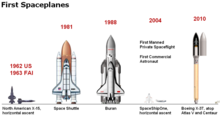
Background
The Soviet reusable spacecraft program has its roots in the late 1950s, at the very beginning of the space age. The idea of Soviet reusable space flight is very old, though it was neither continuous nor consistently organized. Before Buran, no project of the program reached operational status.
The idea saw its first iteration in the Burya high-altitude jet aircraft, which reached the prototype stage. Several test flights were made before it was cancelled by order of the Central Committee. The Burya had the goal of delivering a nuclear payload, presumably to the United States, and then returning to base. The cancellation was based on a final decision to develop ICBMs. The next iteration of the idea was Zvezda from the early 1960s, which also reached a prototype stage. Decades later, another project with the same name was used as a service module for the International Space Station. After Zvezda, there was a hiatus in reusable projects until Buran.
Program development
The development of the Buran began in the early 1970s as a response to the U.S. Space Shuttle program. Soviet officials were concerned about a perceived military threat posed by the U.S. Space Shuttle. In their opinion, the Shuttle's 30-ton payload-to-orbit capacity and, more significantly, its 15-ton payload return capacity, were a clear indication that one of its main objectives would be to place massive experimental laser weapons into orbit that could destroy enemy missiles from a distance of several thousands of kilometres. Their reasoning was that such weapons could only be effectively tested in actual space conditions and that to cut their development time and save costs it would be necessary to regularly bring them back to Earth for modifications and fine-tuning.[8] Soviet officials were also concerned that the U.S. Space Shuttle could make a sudden dive into the atmosphere to drop nuclear bombs on Moscow.[9][10]
In 1974, Valentin Glushko's design bureau, OKB-1 (later NPO Energiya), proposed a new family of heavy-lift rockets called RLA (Russian: РЛА, «Ракетные Летательные Аппараты», romanized: Raketnyye Letatel'niye Apparaty, lit. 'Rocket Flying Apparatus'). The RLA concept included the use of kerosene and liquid hydrogen as fuel, and liquid oxygen as oxidizer (both new technologies in the Soviet space program), with the shuttle orbiter being one possible payload.[11] By 1975, NPO Energiya had come up with two competing designs for the orbiter vehicle: the MTKVP (Russian: МТКВП, «Многоразовый Транспортный Корабль Вертикальной Посадки», romanized: Mnogorazoviy Transportniy Korabl' Vertikal'noy Posadki, lit. 'Reusable Vertical Landing Transport Ship'), a 34 meter-long lifting body spaceplane launched on top of a stack of kerosene-fueled strap on boosters;[12] and the OS-120 (Russian: ОС-120, «Орбитальный Самолет», romanized: Orbital'niy Samolet, lit. 'Orbital Spaceplane–120 tons'), a close copy of the US Space Shuttle composed of a delta-winged spaceplane equipped with three liquid hydrogen engines, strapped to a detachable external tank and four liquid fuel boosters (NPO Energiya even considered the use of solid propellant rocket boosters, further imitating the US Shuttle's configuration).[13] A compromise between these two proposals was achieved by NPO Energiya in January 1976 with the OK-92 (Russian: ОК-92, «Орбитальный Корабль», romanized: Orbital'niy Korabl', lit. 'Orbital Ship–92 tons'), a delta-winged orbiter equipped with two Soloviev D-30 turbofan jet engines for autonomous atmospheric flight, launched to space from a rocket stack made of a core stage with three cryogenic engines, and four kerosene-fueled boosters, each with four engines.[14] By 1978, the OK-92 design was further refined, with its final configuration completed in June 1979.[15]
Soviet engineers were initially reluctant to design a spacecraft that looked superficially identical to the Shuttle. Although it has been commented that wind tunnel testing showed that NASA's design was already ideal,[16] the shape requirements were mandated by its potential military capabilities to transport large payloads to low Earth orbit, themselves a counterpart to the Pentagon's initially projected missions for the Shuttle.[17] Even though the Molniya Scientific Production Association proposed its Spiral program design[18] (halted 13 years earlier), it was rejected as being altogether dissimilar from the American shuttle design. While NPO Molniya conducted development under the lead of Gleb Lozino-Lozinskiy, the Soviet Union's Military-Industrial Commission, or VPK, was tasked with collecting all data it could on the U.S. Space Shuttle. Under the auspices of the KGB, the VPK was able to amass documentation on the American shuttle's airframe designs, design analysis software, materials, flight computer systems and propulsion systems. The KGB targeted many university research project documents and databases, including Caltech, MIT, Princeton, Stanford and others. The thoroughness of the acquisition of data was made much easier as the U.S. shuttle development was unclassified.[19]
The construction of the shuttles began in 1980, and by 1984 the first full-scale Buran was rolled out. The first suborbital test flight of a scale-model (BOR-5) took place as early as July 1983. As the project progressed, five additional scale-model flights were performed. A test vehicle was constructed with four jet engines mounted at the rear; this vehicle is usually referred to as OK-GLI, or as the "Buran aerodynamic analogue". The jets were used to take off from a normal landing strip, and once it reached a designated point, the engines were cut and OK-GLI glided back to land. This provided invaluable information about the handling characteristics of the Buran design, and significantly differed from the carrier plane/air drop method used by the United States and the Enterprise test craft. Twenty-four test flights of OK-GLI were performed by the Gromov Flight Research Institute test pilots and researchers after which the shuttle was "worn out". The developers considered using a couple of Mil Mi-26 helicopters to "bundle" lift the Buran, but test flights with a mock-up showed how risky and impractical that was.[20] The VM-T ferried components[21] and the Antonov An-225 Mriya (the heaviest airplane ever) was designed and used to ferry the shuttle.[22][23]
The flight and ground-testing software also required research. In 1983 the Buran developers estimated that the software development would require several thousand programmers if done with their existing methodology (in assembly language), and they appealed to Keldysh Institute of Applied Mathematics for assistance. It was decided to develop a new high-level "problem-oriented" programming language. Researchers at Keldysh developed two languages: PROL2 (used for real-time programming of onboard systems) and DIPOL (used for the ground-based test systems), as well as the development and debugging environment SAPO PROLOGUE.[24] There was also an operating system known as Prolog Manager.[25] Work on these languages continued beyond the end of the Buran program, with PROL2 being extended into SIPROL,[26] and eventually all three languages developed into DRAKON[citation needed] which is still in use in the Russian space industry. A declassified May 1990 CIA report citing open-source intelligence material states that the software for the Buran spacecraft was written in "the French-developed programming language known as Prolog",[27] possibly due to confusion with the name PROLOGUE.
Flight crew preparation
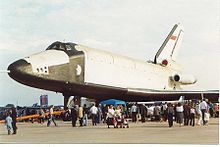
Until the end of the Soviet Union in 1991, seven cosmonauts were allocated to the Buran program and trained on the OK-GLI ("Buran aerodynamic analogue") test vehicle. All had experience as test pilots. They were: Ivan Ivanovich Bachurin, Alexei Sergeyevich Borodai, Anatoli Semyonovich Levchenko, Aleksandr Vladimirovich Shchukin, Rimantas Antanas Stankevičius, Igor Petrovich Volk, and Viktor Vasiliyevich Zabolotsky.
A rule, set in place for cosmonauts because of the failed Soyuz 25 of 1977, insisted that all Soviet space missions contain at least one crew member who has been to space before. In 1982, it was decided that all Buran commanders and their back-ups would occupy the third seat on a Soyuz mission, prior to their Buran spaceflight. Several people had been selected to potentially be in the first Buran crew. By 1985, it was decided that at least one of the two crew members would be a test pilot trained at the Gromov Flight Research Institute (known as "LII"), and potential crew lists were drawn up. Only two potential Buran crew members reached space: Igor Volk, who flew in Soyuz T-12 to the space station Salyut 7, and Anatoli Levchenko who visited Mir, launching with Soyuz TM-4 and landing with Soyuz TM-3. Both of these spaceflights lasted about a week.[8]
Levchenko died of a brain tumour the year after his orbital flight, Bachurin left the cosmonaut corps because of medical reasons, Shchukin was assigned to the back-up crew of Soyuz TM-4 and later died in a plane crash, Stankevičius was also killed in a plane crash, while Borodai and Zabolotsky remained unassigned to a Soyuz flight until the Buran programme ended.
Spaceflight of I. P. Volk

Igor Volk was planned to be the commander of the first crewed Buran flight. There were two purposes of the Soyuz T-12 mission, one of which was to give Volk spaceflight experience. The other purpose, seen as the more important factor, was to beat the United States and have the first spacewalk by a woman.[8] At the time of the Soyuz T-12 mission the Buran program was still a state secret. The appearance of Volk as a crew member caused some, including the British Interplanetary Society magazine Spaceflight, to ask why a test pilot was occupying a Soyuz seat usually reserved for researchers or foreign cosmonauts.[28]
Spaceflight of A. S. Levchenko
Anatoli Levchenko was planned to be the back-up commander of the first crewed Buran flight, and in March 1987 he began extensive training for his Soyuz spaceflight.[8] In December 1987, he occupied the third seat aboard Soyuz TM-4 to Mir, and returned to Earth about a week later on Soyuz TM-3. His mission is sometimes called Mir LII-1, after the Gromov Flight Research Institute shorthand.[29] When Levchenko died the following year, it left the back-up crew of the first Buran mission again without spaceflight experience. A Soyuz spaceflight for another potential back-up commander was sought by the Gromov Flight Research Institute, but never occurred.[8]
Ground facilities
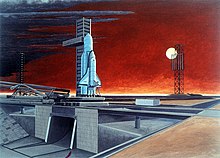
Maintenance, launches and landings of the Buran-class orbiters were to take place at the Baikonur Cosmodrome in the Kazakh SSR. Several facilities at Baikonur were adapted or newly built for these purposes:
- Site 110 – Used for the launch of the Buran-class orbiters. Like the assembly and processing hall at Site 112, the launch complex was originally constructed for the Soviet lunar landing program and later converted for the Energia-Buran program.
- Site 112 – Used for orbiter maintenance and to mate the orbiters to their Energia launchers (thus fulfilling a role similar to the VAB at KSC). The main hangar at the site, called MIK RN or MIK 112, was originally built for the assembly of the N1 moon rocket. After cancellation of the N-1 program in 1974, the facilities at Site 112 were converted for the Energia-Buran program. It was here that Orbiter K1 was stored after the end of the Buran program and was destroyed when the hangar roof collapsed in 2002.[30][31]
- Site 251 – Used as Buran orbiter landing facility, also known as Yubileyniy Airfield (and fulfilling a role similar to the SLF at KSC). It features one runway, called 06/24, which is 4,500 metres (4,900 yd) long and 84 metres (92 yd) wide, paved with "Grade 600" high quality reinforced concrete. At the edge of the runway was a special mating-demating device, designed to lift an orbiter off its Antonov An-225 Mriya carrier aircraft and load it on a transporter, which would carry the orbiter to the processing building at Site 254. A purpose-built orbiter landing control facility, housed in a large multi-storey office building, was located near the runway. Yubileyniy Airfield was also used to receive heavy transport planes carrying elements of the Energia-Buran system. After the end of the Buran program, Site 251 was abandoned but later reopened as a commercial cargo airport. Besides serving Baikonur, Kazakh authorities also use it for passenger and charter flights from Russia.[32][33]
- Site 254 – Built to service the Buran-class orbiters between flights (thus fulfilling a role similar to the OPF at KSC). Constructed in the 1980s as a special four-bay building, it also featured a large processing area flanked by several floors of test rooms. After cancellation of the Buran program it was adapted for pre-launch operations of the Soyuz and Progress spacecraft.[34]
Missions
Following a series of atmospheric test flights using the jet-powered OK-GLI prototype, the first operational spacecraft (Orbiter K1) flew one test mission on 15 November 1988 at 03:00:02 UTC.[35] The spacecraft was launched uncrewed from and landed at Baikonur Cosmodrome in the Kazakh S.S.R. and flew two orbits, travelling 83,707 kilometres (52,013 mi) in 3 hours and 25 minutes (0.14 flight days).[36] Buran never flew again; the program was cancelled shortly after the dissolution of the Soviet Union.[37] In 2002, the collapse of the hangar in which it was stored destroyed the Buran K1 orbiter.[38][39]
Atmospheric test flights
An aerodynamic testbed, OK-GLI, was constructed in 1984 to test the in-flight properties of the Buran design. Unlike the American prototype Space Shuttle Enterprise, OK-GLI had four AL-31 turbofan engines fitted, meaning it was able to fly under its own power.
Orbital flight of Buran 1.01 in 1988
| No | Launch Date | Mission | Shuttle | Crew | Duration | Landing Site | Notes | Sources |
|---|---|---|---|---|---|---|---|---|
| 1 | 15 November 1988 03:00:02 UTC 06:00:02 MSK |
1K1 | Buran | 0 | 3h 25m 22s | Baikonur |
|
[40][41][42][43] |
The only orbital launch of the Buran 1.01 was at 03:00 UTC on 15 November 1988 from pad 110/37 in Baikonur. The uncrewed craft was lifted into orbit by the specially designed Energia booster rocket. The life support system was not installed and no software was installed on the CRT displays.[44] The shuttle orbited the Earth twice in 206 minutes of flight. On its return, it performed an automated landing on the shuttle runway at Baikonur Cosmodrome.[45]
Planned flights
The planned flights for the shuttles in 1989, before the downsizing of the project and eventual cancellation, were:[46]
- 1991 — Ptichka 1.02 uncrewed first flight, duration 1–2 days.
- 1992 — Ptichka 1.02 uncrewed second flight, duration 7–8 days. Orbital manoeuvres and space station approach test.
- 1993 — Buran 1.01 uncrewed second flight, duration 15–20 days.
- 1994 — Orbiter 2.01 first crewed space test flight, duration of 24 hours. Craft equipped with life-support system and with two ejection seats. Crew would consist of two cosmonauts with Igor Volk as commander, and Aleksandr Ivanchenko as flight engineer.
- 1994-1995 - Second, third, fourth and fifth crewed orbital test flights.
The planned uncrewed second flight of Ptichka was changed in 1991 to the following:
- December 1991 — Ptichka 1.02 uncrewed second flight, with a duration of 7–8 days. Orbital manoeuvrers and space station approach test:
- automatic docking with Mir's Kristall module
- crew transfer from Mir to the shuttle, with testing of some of its systems in the course of twenty-four hours, including the remote manipulator
- undocking and autonomous flight in orbit
- docking of the crewed Soyuz TM-101 with Ptichka
- crew transfer from the Soyuz to the shuttle and onboard work in the course of twenty-four hours
- automatic undocking and landing
Cancellation of the program 1993

After the first flight of a Buran shuttle, the project was suspended due to lack of funds and the political situation in the Soviet Union. The two subsequent orbiters, which were due in 1990 (Orbiter 1.02) and 1992 (Orbiter 2.01) were never completed. The project was officially terminated on 30 June 1993, by President Boris Yeltsin. At the time of its cancellation, 20 billion roubles had been spent on the Buran program.[47]
The program was designed to boost national pride, carry out research, and meet technological objectives similar to those of the U.S. Space Shuttle program, including resupply of the Mir space station, which was launched in 1986 and remained in service until 2001. When Mir was finally visited by a spaceplane, the visitor was a Space Shuttle orbiter, not a Buran-class orbiter.
The Buran SO, a docking module that was to be used for rendezvous with the Mir space station, was refitted for use with the U.S. Space Shuttles during the Shuttle–Mir missions.[48]
The cost of a Buran launch carrying a 20 ton payload was estimated at 270 million roubles, vs 5.5 million roubles on the Proton rocket.[49]
Baikonur hangar collapse
On 12 May 2002, a hangar roof at the Baikonur Cosmodrome in Kazakhstan collapsed because of a structural failure due to poor maintenance. The collapse killed eight workers and destroyed one of the Buran-class orbiters (Buran 1.01), which flew the test flight in 1988, as well as a mock-up of an Energia booster rocket. It was not clear to outsiders at the time which Buran-class orbiter was destroyed, and the BBC reported that it was just "a model" of the orbiter.[39] It occurred at the MIK RN/MIK 112 building at Site 112 of the Baikonur Cosmodrome, 14 years after the only Buran flight. Work on the roof had begun for a maintenance project, whose equipment is thought to have contributed to the collapse. Also, before the day of collapse, there had been several days of heavy rain.[8]
Revival possibilities
Over time, several scientists looked into trying to revive the Buran program, especially after the Space Shuttle Columbia disaster.[50]
The 2003 grounding of the U.S. Space Shuttles caused many to wonder whether the Energia launcher or Buran shuttle could be brought back into service.[51] By then, however, all of the equipment for both (including the vehicles themselves) had fallen into disrepair or been repurposed after falling into disuse with the collapse of the Soviet Union.
In 2010 the director of Moscow's Central Machine Building Institute said the Buran program would be reviewed in the hope of restarting a similar crewed spacecraft design, with rocket test launches as soon as 2015.[52] Russia also continues work on the PPTS but has abandoned the Kliper program, due to differences in vision with its European partners.[53][54]
Due to the 2011 retirement of the American Space Shuttle and the need for STS-type craft in the meantime to complete the International Space Station, some American and Russian scientists had been mulling over plans to possibly revive the already-existing Buran shuttles in the Buran program rather than spend money on an entirely new craft and wait for it to be fully developed[50][51] but the plans did not come to fruition.
On the 25th anniversary of the Buran flight in November 2013, Oleg Ostapenko, the new head of Roscosmos, the Russian Federal Space Agency, proposed that a new heavy-lift launch vehicle be built for the Russian space program. The rocket would be intended to place a payload of 100 tonnes (220,000 lb) in a baseline low Earth orbit and is projected to be based on the Angara launch vehicle technology.[55]
Vehicles
Energia launch vehicle
Energia (; GRAU 11K25) was a 1980s super-heavy lift launch vehicle. It was designed by NPO Energia of the Soviet Union as part of the Buran program for a variety of payloads including the Buran spacecraft. Control system main developer enterprise was the Khartron NPO "Electropribor".[56][57] The Energia used four strap-on boosters each powered by a four-chamber RD-170 engine burning kerosene/LOX, and a central core stage with four single-chamber RD-0120 (11D122) engines fueled by liquid hydrogen/LOX.[58]
The launch vehicle had two functionally different operational variants: Energia-Polyus, the initial test configuration, in which the Polyus system was used as a final stage to put the payload into orbit, and Energia-Buran,[59] in which the Buran-class orbiters were the payload and the source of the orbit insertion impulse.
The launch vehicle had the capacity to place about 100 tonnes in Low Earth orbit, up to 20 tonnes to geostationary orbit and up to 32 tonnes by translunar trajectory into lunar orbit.[60]
The launch vehicle made just two flights to orbit before being discontinued.[61][59] Since 2016, there have been attempts to revive the launch vehicle, reusing an updated version of its engine in the Soyuz-5 rocket.Buran orbiter
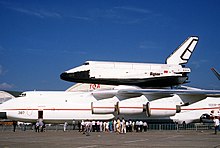
Buran (Russian: Буран, IPA: [bʊˈran], meaning "Snowstorm" or "Blizzard"; GRAU index serial number: 11F35 1K, construction number: 1.01) was the first spaceplane to be produced as part of the Soviet/Russian Buran program. Besides describing the first operational Soviet/Russian shuttle orbiter, "Buran" was also the designation for the entire Soviet/Russian spaceplane project and its orbiters, which were known as "Buran-class orbiters".
Buran completed one uncrewed spaceflight in 1988, and was destroyed in the 2002 collapse of its storage hangar.[62] The Buran-class orbiters used the expendable Energia rocket, a class of super heavy-lift launch vehicle.
It is named after the Asian wind.Antonov An-225 Mriya
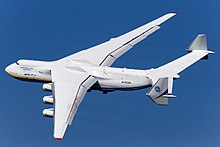
The Antonov An-225 Mriya (Ukrainian: Антонов Ан-225 Мрія, lit. 'dream' or 'inspiration'; NATO reporting name: Cossack) was a strategic airlift cargo aircraft designed in the 1980s by the Antonov Design Bureau in the Soviet Union. It was originally developed as an enlargement of the Antonov An-124 to transport Buran-class orbiters, and only one example was ever completed. After successfully fulfilling its military missions, the aircraft was mothballed for eight years. It was then refurbished and reintroduced into commercial operation with Antonov Airlines, carrying oversized payloads. While a second airframe with a slightly different configuration was partially built, construction was halted more than once due to a lack of funding and interest. This second aircraft was last brought up to 60–70% completion in 2009.
With a maximum takeoff weight of 640 tonnes (705 short tons), the An-225 held several records, including heaviest aircraft ever built and largest wingspan of any aircraft in operational service. The Mriya attracted a high degree of public interest, attaining a global following due to its size and its uniqueness. People frequently visited airports to see its scheduled arrivals and departures.
The completed An-225 was destroyed in the Battle of Antonov Airport during the 2022 Russian invasion of Ukraine.Energia liquid rocket booster
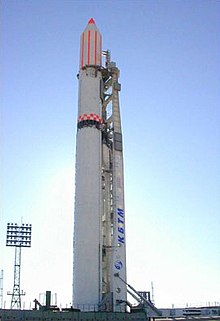
Zenit (Ukrainian: Зеніт, Russian: Зени́т; meaning Zenith) is a family of space launch vehicles designed by the Yuzhnoye Design Bureau in Dnipro, Ukraine, which was then part of the Soviet Union. Zenit was originally built in the 1980s for two purposes: as a liquid rocket booster for the Energia rocket and, equipped with a second stage, as a stand-alone middle-weight launcher with a payload greater than the 7 tonnes of the Soyuz but smaller than the 20 tonnes payload of the Proton. The last rocket family developed in the USSR, the Zenit was intended as an eventual replacement for the dated Soyuz and Proton families, and it would employ propellants which were safer and less toxic than the Proton's nitrogen tetroxide/UDMH mix. Zenit was planned to take over crewed spaceship launches from Soyuz, but these plans were abandoned after the dissolution of the Soviet Union in 1991.
Zenit-3SL was launched by the Sea Launch consortium's floating launch platform in the Pacific Ocean and Zenit-2 is launched from Baikonur Cosmodrome in Kazakhstan. RD-171M engines of the Zenit's first and second stages as well as the upper stage of the Zenit-3SL rocket are supplied by Russia. An improved Zenit-3SLB rocket was used for commercial launches from Baikonur Cosmodrome beginning in April 2008, marketed as Land Launch.[63]
Zenit-3SL has launched 36 times with 32 successes, one partial success, and three failures. The first failure, the launch of a Hughes-built communications satellite owned by ICO Global Communications, occurred during the second commercial launch on March 12, 2000, and was blamed on a software error that failed to close a valve in the second stage of the rocket. The second failure occurred on January 30, 2007, when the rocket exploded on the Odyssey launch platform, seconds after engine ignition. The NSS-8 communication satellite on board was destroyed.[64]
On September 24, 2011 Zenit-3SL launched successfully from the Odyssey launch platform under a renewed Sea Launch project with RSC Energia as the majority stakeholder. The rocket delivered the European communication satellite Atlantic Bird 7 to its planned orbit. On February 1, 2013, another Zenit-3SL failed while launching the Intelsat 27 satellite.[65]Energia-Buran and the US Space Shuttle
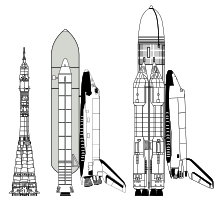
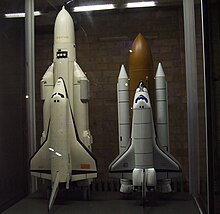
Comparison to NASA's Space Shuttle
Because Buran's debut followed that of Space Shuttle Columbia's, and because there were striking visual similarities between the two shuttle systems—a state of affairs which recalled the similarity between the Tupolev Tu-144 and Concorde supersonic airliners—many speculated that Cold War espionage played a role in the development of the Soviet shuttle. Despite remarkable external similarities, many key differences existed, which suggests that, had espionage been a factor in Buran's development, it would likely have been in the form of external photography or early airframe designs. NASA Administrator James C. Fletcher stated that Buran was based on a rejected NASA design.[66] See the § Program development section above.
Key differences between Energia-Buran system and NASA's Space Shuttle
- Unlike Space Shuttle's boosters, each of Energia's four boosters had their own guidance, navigation, and control system.[67] Known as Zenit-2, they were used as launch vehicles on their own to deliver smaller payloads than those requiring the complete Energia-Buran system.
- Energia could be configured with four, two or no boosters for payloads other than Buran, and in full configuration was able to put up to 100 metric tons into orbit.[60] The Space Shuttle orbiter was integral to its launch system and was the system's only payload.
- Energia's four boosters used liquid propellant (kerosene/oxygen). The Space Shuttle's two boosters used solid propellant.[68]
- The liquid fueled booster rockets were not constructed in segments vulnerable to leakage through O-rings, which caused the destruction of Challenger.[citation needed]
- The Energia rocket was not covered in foam, the shedding of which from the large fuel tank led to the destruction of Columbia. However, this enabled the risk of shedding ice chunks from the rocket instead.[citation needed]
- Energia's four boosters were designed to be recovered after each flight,[9] though they were not recovered during Energia's two operational flights. The Space Shuttle's boosters were recovered and reused.
- Buran's equivalent of the Space Shuttle Orbital Maneuvering System used GOX/LOX/Kerosene propellant, with lower toxicity and higher performance (a specific impulse of 362 seconds (3.55 km/s) using a turbopump system)[69] than the Shuttle's pressure-fed monomethylhydrazine/dinitrogen tetroxide OMS engines.
- Buran was designed to be capable of both piloted and fully autonomous flight, including landing. The Space Shuttle was later retrofitted with automated landing capability, first flown 18 years after the Buran on STS-121, but the system was intended to be used only in contingencies.[70]
- The nose landing gear was located much farther back on the fuselage rather than just under the mid-deck as with the NASA Space Shuttle.[citation needed]
- Buran could lift 30 metric tons into orbit in its standard configuration, comparable to the early Space Shuttle's original 27.8 metric tons[71][72]
- Buran could return 20 tons from orbit,[73][74] vs the Space Shuttle's 15 tons.
- Buran included a drag chute,[75] the Space Shuttle originally did not, but was later retrofitted to include one.
- The lift-to-drag ratio of Buran is cited as 6.5,[76] compared to a subsonic L/D of 4.5 for the Space Shuttle.[77]
- Buran and Energia were moved to the launch pad horizontally on a rail transporter, and then erected and fueled at the launch site.[78][79][80] The Space Shuttle was transported vertically on the crawler-transporter with loaded solid boosters but the main tank was fueled at launch site.[81]
- Buran was intended to carry a crew of up to ten, the Shuttle carried up to eight in regular operation and would have carried more only in a contingency.[72][82]
- Buran has a different carbon-carbon heat tile layout in its underside,[73] in which all gaps between heat tiles are parallel or perpendicular to the direction of airflow through the orbiter.[83]
See also
- MAKS (spacecraft) - Soviet air-launched spaceplane concept
- Mikoyan-Gurevich MiG-105 – Soviet spaceplane test program
- Space Shuttle program - American spaceplane program
- Tupolev OOS - Soviet air-launched spaceplane concept
References
- Воздушно-космический Корабль [Air-Space Ship] (PDF) (in Russian). Archived from the original (PDF) on 20 March 2006. Retrieved 2 June 2015.
- Harvey, Brian (2007). The Rebirth of the Russian Space Programme: 50 Years After Sputnik, New Frontiers. Springer. p. 8. ISBN 978-0-38-771356-4. Archived from the original on 24 June 2016. Retrieved 9 February 2016.
- Russian shuttle dream dashed by Soviet crash. YouTube.com. Russia Today. 15 November 2007. Archived from the original on 11 December 2021. Retrieved 16 July 2009.
- Chertok, Boris E. (May 2009). Siddiqi, Asif A. (ed.). Rockets and People, Volume 3: Hot Days of the Cold War (PDF). NASA History Series. National Aeronautics and Space Administration. ISBN 978-0-16-081733-5. SP-2005-4110. Archived (PDF) from the original on 25 December 2017. Retrieved 12 July 2017.
- Green, Brendan R. & Long, Austin (July 2017). "The MAD Who Wasn't There: Soviet Reactions to the Late Cold War Nuclear Balance". Perceptions of the Nuclear Balance over Time. Security Studies. 26 (4): 606–641. doi:10.1080/09636412.2017.1331639. S2CID 157937593.
- Paul Marks (7 July 2011). "Cosmonaut: Soviet space shuttle was safer than NASA's". Archived from the original on 20 August 2011. Retrieved 25 August 2017.
- "Antonov An-225 Mryia (Cossack)". theAviationZone.com. 2003. Archived from the original on 25 September 2018. Retrieved 1 June 2015.
- Hendrickx & Vis 2007.
- Gubanov, Boris (1998). Triumf i tragediya Energii Триумф и трагедия „Энергии“ [Triumph and Tragedy, Energiya]. Vol. 3. Publisher of the Nizhny Novgorod Institute of Economic Development. p. 33. ISBN 5-93320-002-6. Archived from the original on 1 November 2019. Retrieved 11 March 2021.
- Zak, Anatoly (20 November 2008). "Buran – the Soviet 'space shuttle'". BBC News. Archived from the original on 30 March 2020. Retrieved 7 December 2008.
- Hendrickx & Vis 2007, p. 62.
- Hendrickx & Vis 2007, p. 71.
- Hendrickx & Vis 2007, p. 73.
- Hendrickx & Vis 2007, p. 76.
- Hendrickx & Vis 2007, p. 82.
- Sparrow, Giles (2009). Spaceflight: The Complete Story From Sputnik to Shuttle—and Beyond. DK Publishers. p. 215. ISBN 9780756656416.
- Hendrickx & Vis 2007, p. 83.
- "Аппараты БОР". www.buran.ru. Archived from the original on 13 July 2020. Retrieved 29 November 2020.
- Windrem, Robert (4 November 1997). "How the Soviets stole a space shuttle". NBC News. Archived from the original on 30 March 2020. Retrieved 10 September 2013.
- Fedotov, V. A. "BURAN Orbital Spaceship Airframe Creation". Buran-Energia.com. Archived from the original on 26 November 2012. Retrieved 22 January 2013.
- Petrovitch, Vassili. "VM-T Atlant: Description". Buran-Energia.com. Archived from the original on 25 January 2013. Retrieved 22 January 2013.
- Goebel, Greg. "The Antonov Giants: An-22, An-124, & An-225 – Antonov An-225 Mriya ("Cossack")". Airvectors.net. Archived from the original on 5 December 2012. Retrieved 21 August 2012.
- Goebel, Greg. "Postscript: The Other Shuttles – The Soviet Buran shuttle programme". Vectorsite.net. Archived from the original on 11 December 2011. Retrieved 21 August 2012.
- "Системное и прикладное программирование" [System and application programming]. 50th Anniversary of Institute for Applied Mathematics. Keldysh Institute of Applied Mathematics. 2004. Archived from the original on 14 September 2013. Retrieved 24 March 2015.
- "Отдел программных комплексов" [Department of software systems]. Keldysh Institute of Applied Mathematics. Archived from the original on 5 September 2011. Retrieved 26 March 2015.
- Kryukov, V. & Petrenko, A. (1996). Интегрированный подход к разработке крупных программных систем управления реального времени [An integrated approach to the development of large software systems, real-time control]. Индустрия программирования [Software industry]. Moscow. Archived from the original on 2 April 2015. Retrieved 25 March 2015.
- "Soviet Software Productivity: Isolated Gains in an Uphill Battle" (PDF). Central Intelligence Agency. May 1990. p. 7. SW 90-10029X. Archived from the original (PDF) on 4 August 2016. Retrieved 9 July 2016.
- Hendrickx & Vis 2007, p. 526.
- Wade, Mark. "Mir LII-1". Encyclopedia Astronautica. Archived from the original on 30 November 2010. Retrieved 15 November 2010.
- Zak, Anatoly (7 April 2013). "Centers: Baikonur: Energia-Buran facilities: Site 112". RussianSpaceWeb.com. Archived from the original on 6 July 2015. Retrieved 2 August 2016.
- Petrovitch, Vassili. "End of an adventure". Buran-Energia.com. Archived from the original on 5 September 2017. Retrieved 16 August 2020.
- Zak, Anatoly (7 April 2013). "Centers: Baikonur: Energia-Buran facilities: Site 251". RussianSpaceWeb.com. Archived from the original on 25 February 2015. Retrieved 2 August 2016.
- "UAON". OurAirports. Archived from the original on 17 August 2016. Retrieved 16 August 2020.
- Zak, Anatoly (28 October 2009). "Centers: Baikonur: Energia-Buran facilities: Site 254". RussianSpaceWeb.com. Archived from the original on 9 August 2015. Retrieved 2 August 2016.
- Hendrickx & Vis 2007, p. 349.
- Hendrickx & Vis 2007, p. 356.
- The New Book of Popular Science. Vol. 1. Scholastic. 2008. p. 257. ISBN 9780717212262.
- Hendrickx & Vis 2007, p. 388.
- Whitehouse, David (13 May 2002). "Russia's space dreams abandoned". BBC News. Archived from the original on 21 November 2008. Retrieved 14 November 2007.
- Barringer, Felicity (16 November 1988). "Soviet Space Shuttle Orbits and Returns In Unmanned Debut". The New York Times. Archived from the original on 19 December 2013. Retrieved 23 November 2013.
- R. S. (17 November 1988). "Soviet shuttle". The Christian Science Monitor. Archived from the original on 3 October 2015. Retrieved 15 January 2013.
- "Russia starts ambitious super-heavy space rocket project". Space Daily. 19 November 2013. Archived from the original on 6 October 2014. Retrieved 2 October 2014.
- "Циклограмма полета орбитального корабля "Буран" 15 ноября 1988 г." Buran.ru (in Russian). Archived from the original on 30 April 2020. Retrieved 15 August 2020.
- "Shuttle Buran". NASA.gov. 12 November 1997. Archived from the original on 4 August 2006.
- Chertok, Boris E. (January 2005). Siddiqi, Asif A. (ed.). Rockets and People, Volume 1 (PDF). NASA History Series. National Aeronautics and Space Administration. p. 179. ASIN B0075GLYQG. SP-2005-4110. Archived (PDF) from the original on 29 March 2020. Retrieved 16 August 2020.
- Lukashevich, Vadim. Экипажи "Бурана": Несбывшиеся планы [The Crews of "Buran": Unfulfilled Plans]. Buran.ru (in Russian). Archived from the original on 17 July 2006. Retrieved 5 August 2006.
- Wade, Mark. "Yeltsin cancels Buran project". Encyclopedia Astronautica. Archived from the original on 30 June 2006. Retrieved 2 July 2006.
- Wade, Mark. "Mir-Shuttle Docking Module". Encyclopedia Astronautica. Archived from the original on 8 January 2010. Retrieved 16 July 2009.
- "Buran reusable shuttle". www.russianspaceweb.com. Archived from the original on 15 February 2015. Retrieved 1 June 2015.
- Birch, Douglas (5 February 2003). "Russian space programme is handed new responsibility". The Baltimore Sun. Archived from the original on 3 December 2013. Retrieved 17 October 2008.
- Oberg, James (10 June 2005). "Russia ready to take lead on space station". NBC News. Archived from the original on 20 October 2013. Retrieved 16 July 2009.
- "Russia To Review Its Space Shuttle Project". Xinhua. 28 June 2010. Archived from the original on 9 October 2012. Retrieved 28 July 2010 – via Space Daily.
- "Soviet space shuttle could bail out NASA". Current.com. 31 December 2008. Archived from the original on 8 July 2012. Retrieved 15 July 2009.
- "Russia, Europe abandon joint space project – Roscosmos". RIA Novosti. 29 January 2009. Archived from the original on 2 February 2009. Retrieved 29 January 2009.
- "Russia starts ambitious super-heavy space rocket project". Space Daily. 19 November 2013. Archived from the original on 22 December 2013. Retrieved 13 December 2013.
- Krivonosov, Khartron: Computers for rocket guidance systems
- Control systems for intercontinental ballistic missiles and launch vehicles
- Russian Space Web, Energia page. Accessed 21 September 2010
- "Launch vehicle Energia". RSC Energia. Archived from the original on 27 June 2021.
- B. Hendrickx, "The Origins and Evolution of the Energiya Rocket Family," J. British Interplanetary Soc., Vol. 55, pp. 242-278 (2002).
- Zak, Anatoly (25 December 2018). "Buran reusable orbiter". Russian Space Web. Retrieved 28 June 2019.
- "Land Launch User's Guide Revision B" (PDF). Space International Services. 1 October 2014. Archived from the original (PDF) on 25 June 2016. Retrieved 8 February 2015.
- Harvey, Brian (2007). The Rebirth of the Russian Space Program. Chichester, UK: Praxis. pp. 167–175.
- Bergin, Chris (1 February 2013). "Sea Launch Zenit 3SL with Intelsat 27 fails during first stage flight". NASASpaceflight.com. Retrieved 1 February 2013.
- Weiss, Gus W. (1996). "The Farewell Dossier: Duping the Soviets – A Deception Operation". Studies in Intelligence. Central Intelligence Agency. 39 (5). Archived from the original on 27 October 2019. Retrieved 8 August 2012.
- "Первая ступень ракеты-носителя "Энергия"". Буран.ру. Retrieved 15 July 2022.
- "Space Shuttle: Solid Rocket Boosters". NASA.gov. Archived from the original on 6 April 2013. Retrieved 16 October 2010.
- Lukashevich, Vadim. "Объединенная двигательная установка (ОДУ)" [Joint Propulsion System (JPS)]. Buran.ru. Archived from the original on 20 November 2013. Retrieved 21 November 2013.
- Malik, Tariq (29 June 2006). "Shuttle to Carry Tools for Repair and Remote-Control Landing". Space.com. Archived from the original on 8 March 2014. Retrieved 29 November 2013.
- Wade, Mark. "Shuttle". Encyclopedia Astronautica. Archived from the original on 13 March 2012. Retrieved 20 September 2010.
- Scott, Jeff (5 February 2007). "Soviet Buran Space Shuttle". Aerospaceweb.org. Archived from the original on 7 December 2006. Retrieved 16 October 2004.
- "Buran Orbiter". Archived from the original on 9 November 2020. Retrieved 29 November 2020.
- "Buran". www.astronautix.com. Archived from the original on 2 July 2019. Retrieved 28 June 2019.
- "Шасси (посадочные устройства) орбитального корабля "Буран" (11Ф35)" [Buran landing gear]. Buran.ru (in Russian). Retrieved 15 July 2022.
- ""Molniya" Research & Industrial Corporation". Buran.ru. Archived from the original on 9 November 2016. Retrieved 20 September 2010.
- Chaffee, Norman, ed. (1985). Space Shuttle Technical Conference, Part 1. NASA. p. 258. N85-16889. Archived from the original on 9 November 2016. Retrieved 7 July 2017.
- "Buran, the First Russian Shuttle". EnglishRussia.com. 14 September 2006. Archived from the original on 23 August 2012. Retrieved 21 August 2012.
- "Russian rockets". The Mars Society. Archived from the original on 20 September 2012. Retrieved 21 August 2012.
- "6 Abandoned Mega-Machines: Jumbo Jets, Space Shuttle Transporters & More". Urban Ghosts. 26 January 2011. Archived from the original on 24 August 2012. Retrieved 21 August 2012.
- Sands, Jason (May 2007). "NASA Diesel-Powered Shuttle Hauler – The Crawler". Diesel Power. Archived from the original on 6 November 2014. Retrieved 21 August 2012.
- Ceccacci, Anthony J.; Dye, Paul F. (12 July 2005). "Contingency Shuttle Crew Support (CSCS)/Rescue Flight Resource Book" (PDF). NASA. Archived (PDF) from the original on 1 March 2016. Retrieved 9 September 2014.
- "Раскрой плиток". www.buran.ru. Archived from the original on 30 April 2020. Retrieved 29 November 2020.
Bibliography
- Hendrickx, Bart & Vis, Bert (4 October 2007). Energiya-Buran: The Soviet Space Shuttle. Springer-Praxis. doi:10.1007/978-0-387-73984-7. ISBN 978-0-387-69848-9.
External links
- Buran.ru, official website by NPO Molniya
- Buran.ru unofficial space encyclopedia (ru)
- Buran at Encyclopedia Astronautica
- Buran and Energia at Buran-Energia.com
- Buran at RussianSpaceWeb.com
- Buran: The Soviet Space Shuttle Success Story at TASS (in English)
На других языках
- [en] Buran programme
[ru] Энергия — Буран
«Энергия» — «Буран» — космическая программа советской многоразовой транспортной космической системы (МТКС). Одна из двух реализованных в мире систем МТКС, программа была ответом на аналогичную многоцелевую военно-гражданскую программу США «Спейс шаттл». Свой первый и единственный космический полёт орбитальный космический корабль-космоплан системы «Буран» совершил в беспилотном режиме 15 ноября 1988 года. Программа была начата в 1974 году[1]:3, а в 1993 году было принято решение о прекращении работ и консервации созданного задела[2][3]. Главными конструкторами многоразовой транспортной космической системы «Энергия» — «Буран» были Семенов Юрий Павлович, ответственный за создание системы «Буран» и Губанов Борис Иванович, ответственный за создание ракетного комплекса «Энергия»[1]:2.Другой контент может иметь иную лицензию. Перед использованием материалов сайта WikiSort.org внимательно изучите правила лицензирования конкретных элементов наполнения сайта.
WikiSort.org - проект по пересортировке и дополнению контента Википедии

